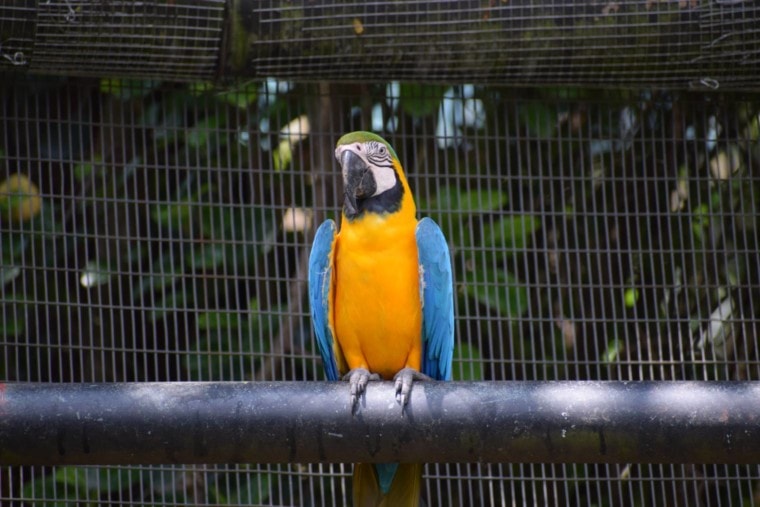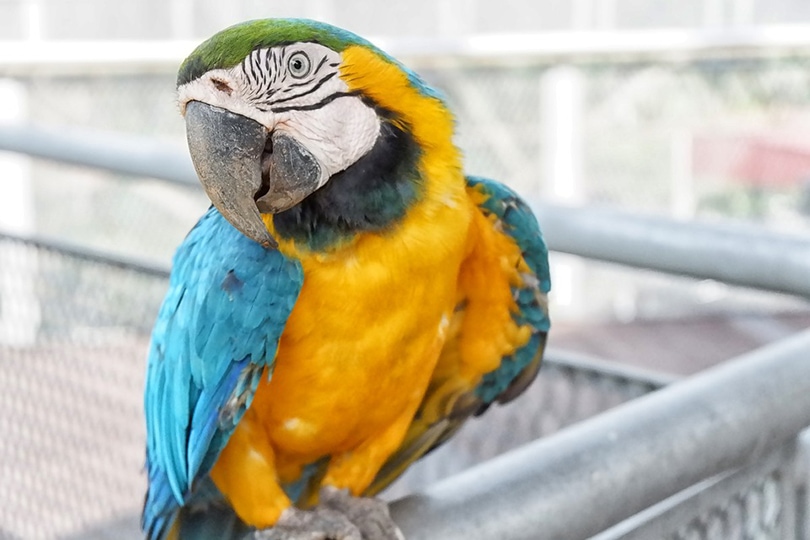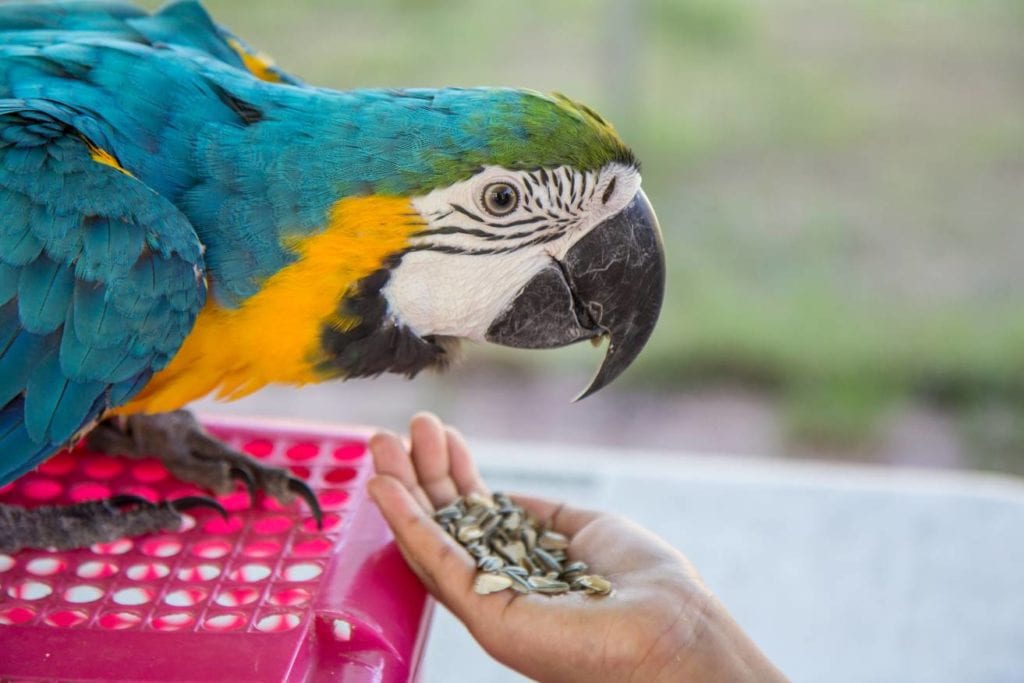
The Blue-and-Gold Macaw is also known as the Blue-and-Yellow Macaw and is one of the most popular of the larger parrots. They are instantly recognizable with their vivid blue and yellow (or gold) feathers and loud and outgoing personalities.
These parrots are amongst the most commonly owned Macaws in North America, so they’re not hard to find and won’t cost you as much as some of the other parrots out there.
If you’re interested in learning more about the Blue-and-Gold Macaw, please read on, and you might learn something new about these gorgeous birds!
Species Overview

| Common Names: | Blue-and-Gold Macaw, Blue-and-Yellow Macaw |
| Scientific Name: | Ara ararauna |
| Adult Size: | 33 inches with a 40-inch wingspan |
| Life Expectancy: | 30 to 60+ years |
Origin and History
The Blue-and-Gold Macaw hails from South and Central America – from Panama to Brazil, Paraguay, Bolivia, and Venezuela south to Peru. They typically inhabit woodlands and forests, usually near water as well as savannas with a few trees and palms as well as forest swamps.
The International Union for Conservation of Nature1 has placed the Blue-and-Yellow Macaw on their Red List as Least Concern, which means they are not under threat, but their species is on the decline in the wild.
They have been traded for the pet industry quite heavily since 1981. They have had one-third of their habitat lost, and at least 60,000 of Blue-and-Gold Macaws have been trapped for the pet trade industry over the last 6 years.
Temperament
In the wild, these parrots tend to stay in pairs or small family groups quite high in the trees. But early in the morning and in the late afternoon, they join up with large and noisy flocks while feeding. When they fly in pairs (probably bonded), they are known to fly very close to each other so that their wings touch.
Blue-and-Gold Macaws have very large personalities that go with their vibrant colors. They can be quite loud and boisterous birds, but they can also be quite loving and affectionate with their humans. These Macaws are very social birds that are very even-tempered and sweet and will seek attention quite willingly. They are also very playful and inquisitive but can be very sensitive birds.
Blue-and-Gold Macaws are very intelligent and can be taught tricks. They aren’t shy about showing you how they feel. They’ll fluff out their feathers and maybe even scream if they don’t want you to come near them. But they’ll also rub their heads against you when in an affectionate mood and will give you kisses.
Speech & Vocalizations
The Blue-and-Gold Macaw has loud and harsh calls with a variety of croaking type sounds and is prone to screaming or screeching. Once they start screaming, you really can’t stop them, so these birds are definitely not a good fit for people in apartments or living in close quarters to others.
Beyond that, they are famous for their talking ability. These smart birds are quick learners and can pick up a vocabulary of about 20 or so words (or more or less, depending on the bird and the owner).
Blue-and-Gold Macaw Colors and Markings

The Blue-and-Gold Macaw is, well, blue and gold. The upper part of their bodies, including their wings, is a bright turquoise blue, and the undersides going up to the sides of their heads is a vivid golden-yellow.
They also sport green foreheads and black under their beaks. And interestingly, they are partially white on their faces that will blush pink when they are excited. The females and the males look alike and are quite difficult to tell apart.
They have black beaks, which are quite large and strong and pretty intimidating, which they use for crushing nuts and climbing. Their feet are dark gray with four toes that they use for climbing and grasping objects.
Caring for the Blue-and-Gold Macaw
Enclosure
Other than the Macaw itself, the cage for this bird will be one of the more expensive purchases that you’ll need to make. Your parrot should be able to stretch out his wings and flap them without hitting anything. Given that they have a 40-inch wingspan, the Blue-and-Gold Macaw will require a large enclosure.
At a minimum, it needs to be about 3’ W x 4’ L x 5’ H, but bigger is always better. The bar spacing should be 1 to 1½ inches apart. You can also consider turning one room in your home into a bird-safe room.
Enrichment
Macaws are known for their chewing, so you’ll need to provide your bird with a lot of things that he can safely chew on – items such as pine cones, fir branches, and wood designed for birds. They really enjoy exploring objects by pulling them apart or breaking them.
You can also purchase toys made specifically for large Macaws and big perches that you can place around your home.
Macaws don’t necessarily need a bath, so if your parrot doesn’t seem to like them, you don’t need to force it. Otherwise, just make water available to your Macaw, and he can look after himself.
Socializing
It isn’t necessary to bring another bird into your home as a companion for your Macaw. If you are able to spend a lot of time with your bird, that is usually enough for most Macaws.
If you socialize your Blue-and-Gold while he’s growing up to be comfortable around other people, birds, or pets, he will be much more comfortable around different species. However, it’s not recommended to allow your Macaw to spend time outside of his cage with a smaller bird without supervision.

Common Health Problems
Some of the more typical health issues that your Blue-and-Gold Macaw might be susceptible to are:
Some of the signs that your Macaw might be sick include:
You know your bird best, so you’ll be able to recognize when there’s something wrong with your pet. Do consult your avian vet if you observe these symptoms.
Diet and Nutrition
When in the wild, the Blue-and-Gold Macaw eats a variety of nuts, seeds, and fruit – mainly palm tree fruit.
You can give your parrot a pelleted diet that includes healthy seeds such as chia, flax, and hemp, as well as sprouted or soaked sunflower seeds.

Exercise
The Blue-and-Gold Macaw is a very active and energetic bird. They need time outside of their cage so they can stretch and beat their wings.
You should encourage climbing on your stairs or provide them with a rope ladder, which can help strengthen their legs and feet.
Place your Macaw on your arm and gently move your arm up and down or around in circles. This will cause your Macaw to beat his wings to keep his balance.
Try playing games and putting on music to get your Blue-and-Gold dancing, and be sure to provide him with plenty of toys inside his cage to encourage exercise inside as well.
You should allow your Macaw at least 2 to 3 hours of time outside of his cage to give him the opportunity to exercise as well as socialize.
Where to Adopt or Buy a Blue-and-Gold Macaw
Luckily, the Blue-and-Gold Macaw is a fairly common parrot that you can find at a breeder’s or in a reputable pet store. However, Macaws tend to be pricey, so you can expect to pay anywhere from $2,000 and up to $5,000 for the Blue-and-Gold.
There are also many bird rescue groups scattered around North America, such as Bird Haven that is based out of Texas. You can take home a Macaw that has been rescued and give him a new and loving home.
You should be able to find one of these Macaws online or through word of mouth. Posting on social media can help (and don’t forget to also search under the Blue-and-Yellow Macaw name as well) and look into joining a parrot group or forum for advice.
Final Thoughts
If you’ve decided you would like to invest in a Blue-and Gold Macaw as your new pet, be sure to check on how your potential parrot has been raised and what his history is before you bring him home.
The Blue-and-Gold Macaw is an amazing bird! They’re beautiful to look at and can make unique and loving companions for the right family.
Featured Image Credit: K.K.T Madhusanka, Shutterstock








